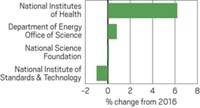Advertisement
Grab your lab coat. Let's get started
Welcome!
Welcome!
Create an account below to get 6 C&EN articles per month, receive newsletters and more - all free.
It seems this is your first time logging in online. Please enter the following information to continue.
As an ACS member you automatically get access to this site. All we need is few more details to create your reading experience.
Not you? Sign in with a different account.
Not you? Sign in with a different account.
ERROR 1
ERROR 1
ERROR 2
ERROR 2
ERROR 2
ERROR 2
ERROR 2
Password and Confirm password must match.
If you have an ACS member number, please enter it here so we can link this account to your membership. (optional)
ERROR 2
ACS values your privacy. By submitting your information, you are gaining access to C&EN and subscribing to our weekly newsletter. We use the information you provide to make your reading experience better, and we will never sell your data to third party members.
Policy
Stimulating Science With More R&D Funds
House puts science funds in economic stimulus bill
by Rochelle Bohaty
January 26, 2009
| A version of this story appeared in
Volume 87, Issue 4
THE HOUSE of Representatives' massive economic stimulus package unveiled on Jan. 15 includes $550 billion in targeted investments, at least $10.5 billion of which would go to fund science.
The National Science Foundation, the National Institute of Standards & Technology, the National Aeronautics & Space Administration, and the Department of Energy are among the science agencies set to benefit from the proposed legislation. NSF is slated to gain the most with an additional $3 billion over the next 20 months. This temporary boost is equal to half of NSF's current budget of $6 billion and would push NSF's funding far beyond the level authorized in the America Competes Act (C&EN, Sept. 15, 2008, page 31).
The package also provides tens of billions of dollars to encourage new U.S.-based energy technologies that can support future business growth. For example, it includes $11 billion to create a reliable, efficient electricity grid. It also allocates $2 billion to support energy-efficiency and renewable-energy research, $2 billion to fund loans and grants for advanced battery R&D, and nearly $9 billion to promote home energy efficiency and weatherization programs. A large percentage of this energy-related funding is expected to go to DOE.
Scientific organizations including the American Chemical Society, which publishes C&EN, welcomed the proposed R&D funding increases. "ACS is truly pleased that the new Congress and Administration have recognized again the importance of innovation funding to U.S. economic competitiveness," says Caroline Trupp-Gil, ACS assistant director of advocacy.
At a Jan. 21 House Appropriations Committee hearing, however, members of both parties criticized the bill for its enormous size and its timeline for funding distribution. Other concerns include oversight and management details of the bill. For example, some representatives are afraid that if DOE receives billions of dollars to support non-research-related energy programs, the agency will be forced to change from a research-driven organization to a grant-management agency.
Republicans in the House are extremely concerned about the speed with which the bill has been put together and their party's lack of input. Despite the concerns, House Democratic leaders are pushing for a Jan. 28 floor vote so that the bill can be finalized by Congress' Feb. 13 recess.
The Senate had not released the details of its economic recovery package as of C&EN's press time. But as in the House, leaders in the Senate intend to finalize a bill by next month's recess.




Join the conversation
Contact the reporter
Submit a Letter to the Editor for publication
Engage with us on Twitter